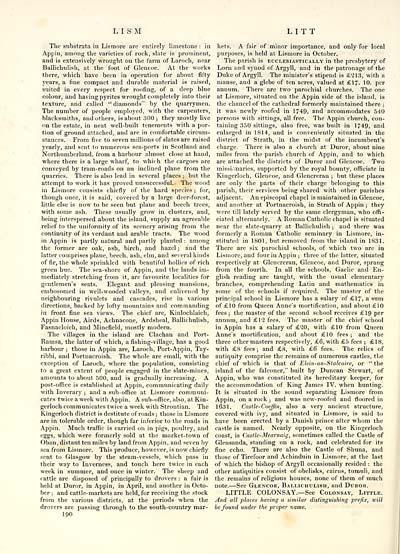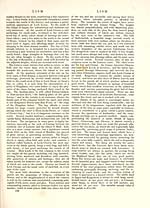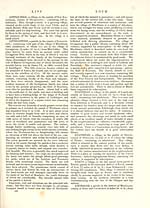Topographical dictionary of Scotland > Volume 2
(198) Page 190
Download files
Complete book:
Individual page:
Thumbnail gallery: Grid view | List view

LI S M
L ITT
The substrata in Lismore are entirely limestone : in
Appiu, among the varieties of rock, slate is prominent,
and is extensively wrought on the farm of Laroch, near
Ballicbulish, at the foot of Glencoe. At the works
there, which have been in operation for about fifty
years, a fine compact and durable material is raised,
suited in every respect for roofing, of a deep blue
colour, and having pyrites wrought completely into their
texture, and called "diamonds" by the quarrymen.
The number of people employed, with the carpenters,
blacksmiths, and others, is about 300 ; they mostly live
on the estate, in neat well-built tenements with a por-
tion of ground attached, and are in comfortable circum-
stances. From five to seven millions of slates are raised
yearly, and sent to numerous sea-ports in Scotland and
Northumberland, from a harbour almost close at hand,
where there is a large wharf, to which the cargoes are
conveyed by tram-roads on an inclined plane from the
quarries. There is also lead in several places ; but the
attempt to work it has proved unsuccessful. The wood
in Lismore consists chiefly of the hard species ; for,
though once, it is said, covered by a large deer-forest,
little else is now to be seen but plane and beech trees,
with some ash. These usually grow in clusters, and,
being interspersed about the island, supply an agreeable
relief to the uniformity of its scenery arising from the
continuity of its verdant and arable tracts. The wood
in Appin is partly natural and partly planted : among
the former are oak, ash, birch, and hazel ; and the
latter comprises plane, beech, ash, elm, and several kinds
of fir, the whole sprinkled with beautiful hollies of rich
green hue. The sea-shore of Appin, and the lands im-
mediately stretching from it, are favourite localities for
gentlemen's seats. Elegant and pleasing mansions,
embosomed in well-wooded valleys, and enlivened by
neighbouring rivulets and cascades, rise in various
directions, backed by lofty mountains and commanding
in front fine sea views. The chief are, Kinlochlaich,
Appin House, Airds, Achnacone, Ardsheal, Ballichulish,
Fasnacloich, and Minefield, mostly modern.
The villages in the island are Clachan and Port-
Ramsa, the latter of which, a fishing-village, has a good
harbour ; those in Appin are, Laroch, Port-Appin, Tay-
ribbi, and Portnacroish. The whole are small, with the
exception of Laroch, where the population, consisting
to a great extent of people engaged in the slate-mines,
amounts to about 500, and is gradually increasing. A
post-office is established at Appin, communicating daily
with Inverary ; and a sub-office at Lismore communi-
cates twice a week with Appin. A sub-office, also, at Kin-
gerloch communicates twice a week with Strontian. The
Kingerloch district is destitute of roads; those in Lismore
are in tolerable order, though far inferior to the roads in
Appin. Much traffic is carried on in pigs, poultry, and
eggs, which were formerly sold at the market-town of
Oban, distant ten miles by land from Appin, and seven by
sea from Lismore. This produce, however, is now chiefly
sent to Glasgow by the steam-vessels, which pass in
their way to Inverness, and touch here twice in each
week in summer, and once in winter. The sheep and
cattle are disposed of principally to drovers : a fair is
held at Duror, in Appin, in April, and another in Octo-
ber ; and cattle-markets are held, for receiving the stock
from the various districts, at the periods when the
drovers are passing through to the south-country mar-
190
kets. A fair of minor importance, and only for local
purposes, is held at Lismore in October.
The parish is ecclesiastically in the presbytery of
Lorn and synod of Argyll, and in the patronage of the
Duke of Argyll. The minister's stipend is £213, with a
manse, and a glebe of ten acres, valued at £17. 10. per
annum. There are two parochial churches. The one
at Lismore, situated on the Appin side of the island, is
the chancel of the cathedral formerly maintained there ;
it was newly roofed in 1749, and accommodates 540
persons with sittings, all free. The Appin church, con-
taining 350 sittings, also free, was built in 1749, and
enlarged in 1S14, and is conveniently situated in the
district of Strath, in the midst of the incumbent's
charge. There is also a church at Duror, about nine
miles from the parish church of Appin, and to which
are attached the districts of Duror and Glencoe. Two
missionaries, supported by the royal bounty, officiate in
Kingerloch, Glencoe, and Glencreran ; but these places
are only the parts of their charge belonging to this
parish, their services being shared with other parishes
adjacent. An episcopal chapel is maintained in Glencoe,
and another at Portnacroish, in Strath of Appin ; they
were till lately served by the same clergyman, who offi-
ciated alternately. A Roman Catholic chapel is situated
near the slate-quarry at Ballichulish ; and there was
formerly a Roman Catholic seminary in Lismore, in-
stituted in 1S01, but removed from the island in 1831.
There are six parochial schools, of which two are in
Lismore, and four in Appin ; three of the latter, situated
respectively at Glencreran, Glencoe, and Duror, sprang
from the fourth. In all the schools, Gaelic and En-
glish reading are taught, with the usual elementary
branches, comprehending Latin and mathematics in
some of the schools if required. The master of the
principal school in Lismore has a salary of £17, a sum
of £10 from Queen Anne's mortification, and about £10
fees; the master of the second school receives £19 per
annum, and £12 fees. The master of the chief school
in Appin has a salary of £20, with £10 from Queen
Anne's mortification, and about £10 fees ; and the
three other masters respectively, £6, with £5 fees ; £1S,
with £8 fees ; and £8, with £6 fees. The relics of
antiquity comprise the remains of numerous castles, the
chief of which is that of Elein-an-Stalcaire, or "the
island of the falconer," built by Duncan Stewart, of
Appin, who was constituted its hereditary keeper, for
the accommodation of King James IV. when hunting.
It is situated in the sound separating Lismore from
Appin, on a rock ; and was new-roofed and floored in
1631. Castle-Coeffin, also a very ancient structure,
covered with ivy, and situated in Lismore, is said to
have been erected by a Danish prince after whom the
castle is named. Nearly opposite, on the Kingerloch
coast, is Castle-Mearnaig, sometimes called the Castle of
Glensanda, standing on a rock, and celebrated for its
fine echo. There are also the Castle of Shuna, and
those of Tirefoor and Achinduin in Lismore, at the last
of which the bishop of Argyll occasionally resided : the
other antiquities consist of obelisks, cairns, tumuli, and
the remains of religious houses, none of them of much
note. — See Glencoe, Ballichulish, and Duror.
LITTLE COLONSAY.— See Colonsay, Little.
And all places having a similar distinguishing prefix, will
be found under the proper name.
L ITT
The substrata in Lismore are entirely limestone : in
Appiu, among the varieties of rock, slate is prominent,
and is extensively wrought on the farm of Laroch, near
Ballicbulish, at the foot of Glencoe. At the works
there, which have been in operation for about fifty
years, a fine compact and durable material is raised,
suited in every respect for roofing, of a deep blue
colour, and having pyrites wrought completely into their
texture, and called "diamonds" by the quarrymen.
The number of people employed, with the carpenters,
blacksmiths, and others, is about 300 ; they mostly live
on the estate, in neat well-built tenements with a por-
tion of ground attached, and are in comfortable circum-
stances. From five to seven millions of slates are raised
yearly, and sent to numerous sea-ports in Scotland and
Northumberland, from a harbour almost close at hand,
where there is a large wharf, to which the cargoes are
conveyed by tram-roads on an inclined plane from the
quarries. There is also lead in several places ; but the
attempt to work it has proved unsuccessful. The wood
in Lismore consists chiefly of the hard species ; for,
though once, it is said, covered by a large deer-forest,
little else is now to be seen but plane and beech trees,
with some ash. These usually grow in clusters, and,
being interspersed about the island, supply an agreeable
relief to the uniformity of its scenery arising from the
continuity of its verdant and arable tracts. The wood
in Appin is partly natural and partly planted : among
the former are oak, ash, birch, and hazel ; and the
latter comprises plane, beech, ash, elm, and several kinds
of fir, the whole sprinkled with beautiful hollies of rich
green hue. The sea-shore of Appin, and the lands im-
mediately stretching from it, are favourite localities for
gentlemen's seats. Elegant and pleasing mansions,
embosomed in well-wooded valleys, and enlivened by
neighbouring rivulets and cascades, rise in various
directions, backed by lofty mountains and commanding
in front fine sea views. The chief are, Kinlochlaich,
Appin House, Airds, Achnacone, Ardsheal, Ballichulish,
Fasnacloich, and Minefield, mostly modern.
The villages in the island are Clachan and Port-
Ramsa, the latter of which, a fishing-village, has a good
harbour ; those in Appin are, Laroch, Port-Appin, Tay-
ribbi, and Portnacroish. The whole are small, with the
exception of Laroch, where the population, consisting
to a great extent of people engaged in the slate-mines,
amounts to about 500, and is gradually increasing. A
post-office is established at Appin, communicating daily
with Inverary ; and a sub-office at Lismore communi-
cates twice a week with Appin. A sub-office, also, at Kin-
gerloch communicates twice a week with Strontian. The
Kingerloch district is destitute of roads; those in Lismore
are in tolerable order, though far inferior to the roads in
Appin. Much traffic is carried on in pigs, poultry, and
eggs, which were formerly sold at the market-town of
Oban, distant ten miles by land from Appin, and seven by
sea from Lismore. This produce, however, is now chiefly
sent to Glasgow by the steam-vessels, which pass in
their way to Inverness, and touch here twice in each
week in summer, and once in winter. The sheep and
cattle are disposed of principally to drovers : a fair is
held at Duror, in Appin, in April, and another in Octo-
ber ; and cattle-markets are held, for receiving the stock
from the various districts, at the periods when the
drovers are passing through to the south-country mar-
190
kets. A fair of minor importance, and only for local
purposes, is held at Lismore in October.
The parish is ecclesiastically in the presbytery of
Lorn and synod of Argyll, and in the patronage of the
Duke of Argyll. The minister's stipend is £213, with a
manse, and a glebe of ten acres, valued at £17. 10. per
annum. There are two parochial churches. The one
at Lismore, situated on the Appin side of the island, is
the chancel of the cathedral formerly maintained there ;
it was newly roofed in 1749, and accommodates 540
persons with sittings, all free. The Appin church, con-
taining 350 sittings, also free, was built in 1749, and
enlarged in 1S14, and is conveniently situated in the
district of Strath, in the midst of the incumbent's
charge. There is also a church at Duror, about nine
miles from the parish church of Appin, and to which
are attached the districts of Duror and Glencoe. Two
missionaries, supported by the royal bounty, officiate in
Kingerloch, Glencoe, and Glencreran ; but these places
are only the parts of their charge belonging to this
parish, their services being shared with other parishes
adjacent. An episcopal chapel is maintained in Glencoe,
and another at Portnacroish, in Strath of Appin ; they
were till lately served by the same clergyman, who offi-
ciated alternately. A Roman Catholic chapel is situated
near the slate-quarry at Ballichulish ; and there was
formerly a Roman Catholic seminary in Lismore, in-
stituted in 1S01, but removed from the island in 1831.
There are six parochial schools, of which two are in
Lismore, and four in Appin ; three of the latter, situated
respectively at Glencreran, Glencoe, and Duror, sprang
from the fourth. In all the schools, Gaelic and En-
glish reading are taught, with the usual elementary
branches, comprehending Latin and mathematics in
some of the schools if required. The master of the
principal school in Lismore has a salary of £17, a sum
of £10 from Queen Anne's mortification, and about £10
fees; the master of the second school receives £19 per
annum, and £12 fees. The master of the chief school
in Appin has a salary of £20, with £10 from Queen
Anne's mortification, and about £10 fees ; and the
three other masters respectively, £6, with £5 fees ; £1S,
with £8 fees ; and £8, with £6 fees. The relics of
antiquity comprise the remains of numerous castles, the
chief of which is that of Elein-an-Stalcaire, or "the
island of the falconer," built by Duncan Stewart, of
Appin, who was constituted its hereditary keeper, for
the accommodation of King James IV. when hunting.
It is situated in the sound separating Lismore from
Appin, on a rock ; and was new-roofed and floored in
1631. Castle-Coeffin, also a very ancient structure,
covered with ivy, and situated in Lismore, is said to
have been erected by a Danish prince after whom the
castle is named. Nearly opposite, on the Kingerloch
coast, is Castle-Mearnaig, sometimes called the Castle of
Glensanda, standing on a rock, and celebrated for its
fine echo. There are also the Castle of Shuna, and
those of Tirefoor and Achinduin in Lismore, at the last
of which the bishop of Argyll occasionally resided : the
other antiquities consist of obelisks, cairns, tumuli, and
the remains of religious houses, none of them of much
note. — See Glencoe, Ballichulish, and Duror.
LITTLE COLONSAY.— See Colonsay, Little.
And all places having a similar distinguishing prefix, will
be found under the proper name.
Set display mode to: Large image | Transcription
Images and transcriptions on this page, including medium image downloads, may be used under the Creative Commons Attribution 4.0 International Licence unless otherwise stated. ![]()
| Gazetteers of Scotland, 1803-1901 > Topographical dictionary of Scotland > Volume 2 > (198) Page 190 |
|---|
| Permanent URL | https://digital.nls.uk/97363505 |
|---|
| Description | Volume II: From Keanlochbervie to Zetland. |
|---|---|
| Attribution and copyright: |
|

